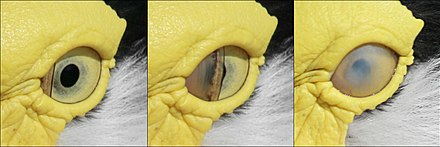
The nictitating membrane (from Latin nictare, to blink) is a transparent or translucent third eyelid present in some animals that can be drawn across the eye from the medial canthus to protect and moisten it while maintaining vision. Most Anura[1][a] (tailless amphibians), some reptiles, birds, and sharks, and some mammals (such as cats, beavers, polar bears, seals and aardvarks) have full nictitating membranes; in many other mammals, a small, vestigial portion of the nictitating membrane remains in the corner of the eye. It is often informally called a third eyelid or haw; the scientific terms for it are the plica semilunaris, membrana nictitans, or palpebra tertia.
- ^ Rolleston, George; Jackson, William Hatchett (1898). Forms of Animal Life : A Manual of Comparative Anatomy, with Descriptions of Selected Types. Clarendon Press. p. 401.
- ^ Vitt, Laurie J.; Caldwell, Janalee P. (2009). "Chapter 17 – Frogs". Herpetology: An Introductory Biology of Amphibians and Reptiles (Third ed.). Academic Press. pp. 435–482. doi:10.1016/B978-0-12-374346-6.00017-1. ISBN 978-0-12-374346-6.
Cite error: There are <ref group=lower-alpha> tags or {{efn}} templates on this page, but the references will not show without a {{reflist|group=lower-alpha}} template or {{notelist}} template (see the help page).